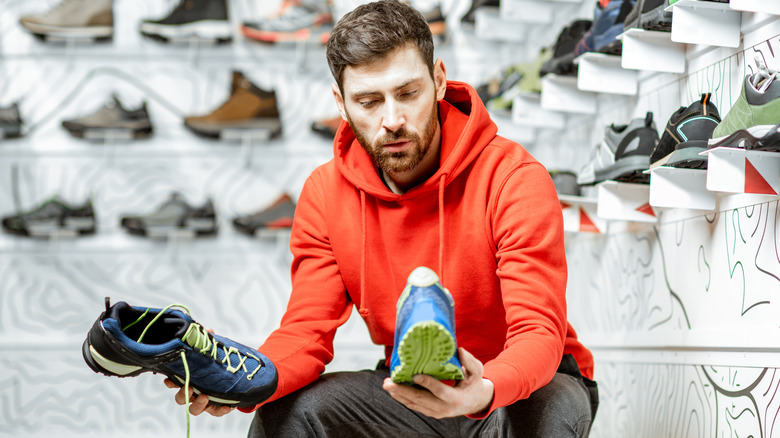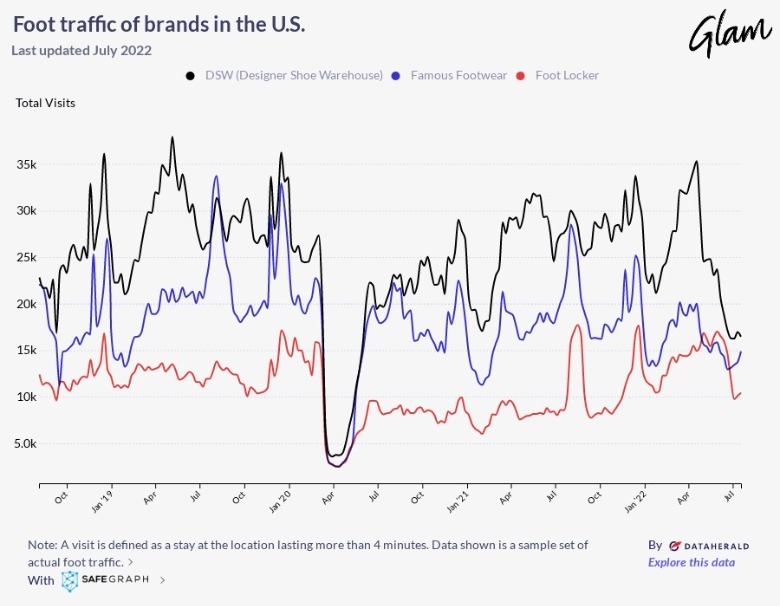Here's How Shoe Stores Returned To Pre-COVID Foot Traffic Levels So Quickly
For many retailers, COVID-19 lockdowns ushered in a comprehensive shift in their business models as customers flocked online. And this shift wasn't necessarily a temporary one — major players like Sephora are having a harder time recovering after COVID-19 than anyone expected. But, for some reason, shoe stores have bucked this trend, climbing smoothly back to their pre-COVID status quo of visitors.
Data collected by SafeGraph tells a compelling story. Like other storefronts across industries, shoe stores saw a precipitous drop in foot traffic when COVID-19 struck the world. But unlike many of those other retailers, shoe stores then saw a quick recovery in visitors, with some reaching near pre-pandemic levels within a few short months. Take, for example, data for Designer Shoe Warehouse (DSW). In 2020, its in-store traffic plummeted from 27,336 on March 2 to a mere 3,567 on March 30. This means that in just 28 days, foot traffic decreased by almost 87%. But while the pandemic would continue to affect the nation for years, DSW's visitors had bounced back to the 20 thousand range in just three months, reaching 22,265 by June 15.
We see similar patterns at other shoe retailers like Famous Footwear. From March to June 2020, Famous Footwear went from a peak of 22,120 visitors in a single day to a low of 2,474 before springing back to 19,780. Again, this rollercoaster of attendance took barely three months. So, what set these stores apart? What traffic-driving advantage did shoe stores have that other fashion retailers couldn't match?
Shoe stores meet a lifestyle need
To some degree, shoe stores got lucky because their two primary advantages in recovering foot traffic weren't strategic — they were circumstantial. For one thing, consumers tend to be very particular about shoes and want to try them on in-store more so than other clothing items. Shoes aren't just about the look; they're also about the feel. Despite the overall exodus to online shopping, customers want a chance to walk around in a potential shoe purchase and feel their gait before coughing up cash for them.
The ongoing success of shoe stores also benefited from activity shifts during the pandemic. While lockdowns cut off consumers from their usual social habits, outdoor activity drew new attention. A study published in Land reports that 20% of people enjoying the great outdoors were "new outdoor recreationists." And according to The Trust for Public Land, many local parks reported record-breaking attendance numbers as more people turned to nature.
That 20% of new recreationists likely needed fresh gear, and sports shoes/boots are among the most widely required gear for any outdoor activity. Even people with gym memberships may have needed different shoes for the outdoors, especially considering that gyms were hit hard by closures in 2020, with one in five shutting down permanently (via IHRSA).
Ultimately, shoes fit into their niche as the essential workers of the fashion sector. While remote work may have pushed consumers away from office attire, the ongoing need for outdoor shoes and trying them on in person may have contributed to shoe retailers' fast and sustained foot traffic recovery.

